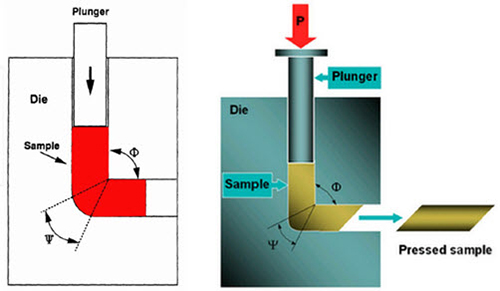Equal Channel Angular Pressing (ECAP): Part One
Abstract
Equal Channel Angular Pressing (ECAP) is one of the most effective severe plastic deformation (SPD) techniques for producing nanostructured or ultrafine-grained materials at low homologous temperatures. The process introduces large shear strains through repeated extrusion steps while maintaining the original cross-sectional dimensions of the workpiece. This unique characteristic allows for cumulative strain application, resulting in exceptional grain refinement. ECAP shows particular promise for industrial-scale applications due to its ability to process relatively large samples. Researchers have extensively studied ECAP for various metals including aluminum alloys, copper, and titanium, with titanium showing significant potential for biomedical applications such as orthopedic implants.
Introduction to Severe Plastic Deformation
Among the various methods used to produce nanostructured materials, severe plastic deformation (SPD) processes demonstrate unique potential for producing relatively large samples suitable for industrial applications. Severe plastic deformation encompasses metal forming processes that introduce ultra-large plastic strain into bulk metals to create nano- or ultrafine-grained structures at low homologous temperatures (typically below 0.3 of the melting temperature).
To achieve the smallest possible microstructural sizes, plastic strains exceeding 600 to 800% are necessary. Such extreme degrees of plastic deformation are achievable because a single sample can undergo multiple SPD cycles, allowing for accumulation of the total plastic strain required for optimal grain refinement.
ECAP: Principles and Mechanisms
Equal Channel Angular Pressing (ECAP) stands as one of the most widely employed methods of Severe Plastic Deformation. This technique can be applied to diverse metals and alloys to obtain ultrafine grains and enhanced mechanical and physical properties. Recent literature demonstrates growing interest in fundamental aspects of SPD techniques, particularly regarding ultrafine grain generation and the mechanisms behind the high strength levels observed in processed materials. Aluminum and its alloys, copper, and titanium are the most frequently studied materials in SPD-ECAP research, with titanium receiving particular attention for potential orthopedic implant applications.
Current research and development of titanium alloys for biomedical applications focuses on developing alloys with low elastic modulus that are free from toxic and allergic elements such as aluminum and vanadium, while maintaining the excellent mechanical properties characteristic of Ti-6Al-4V.
ECAP Process and Implementation
For producing large-size stock suitable for industrial applications, the equal channel angular pressing process offers distinct advantages. This process involves introducing large shear strain in the workpiece by pushing it through a die consisting of two channels with identical cross-sectional shapes that intersect at an angle. Since both channels maintain the same cross-section, the extruded product can be reinserted into the entrance channel and processed again. Repeated extrusion through the ECAP die accumulates sufficient strain to break down the microstructure and produce ultrafine grain sizes.
The principle of ECAP is illustrated schematically in Figure 1. The die's internal channel is bent through an abrupt angle, Φ, with an additional angle, Ψ, representing the outer arc of curvature where the two channels intersect. The sample, typically in rod or bar form, is machined to fit within the channel, and the die is secured so that the sample can be pressed through using a plunger.

Figure 1: Illustration of the ECAP process showing the die geometry with angles Φ and Ψ
The imposed deformation during ECAP is simple shear, occurring as the billet passes through the die. The retention of the same cross-sectional area during processing, despite the introduction of very large strains, represents a critical characteristic of SPD processing. This feature fundamentally distinguishes ECAP from conventional metal-working operations such as rolling, extrusion, and drawing. Since the cross-sectional area remains unchanged, the same billet may be pressed repetitively to achieve exceptionally high strain levels.
About Total Materia
Total Materia is the leading materials information platform, providing the most extensive information on metallic and non-metallic material properties and other material records.
All this information is available in Total Materia Horizon, the ultimate materials information and selection tool, providing unparalleled access to over 540,000 materials as well as, curated and updated reference data.
Total Materia Horizon includes:
- Comprehensive data on mechanical, physical properties
- >80 Global standards and their equivalencies
- Precision tools for comparison and analytics streamlining the selection process.
- Stress-strain, formability, fatigue, creep and fracture data
- Exports to over 25 CAx formats.
- Heat treatment, metallography, corrosion information
- Welding, brazing and adhesives data
- Monthly updated, traceable sources ensure reliability